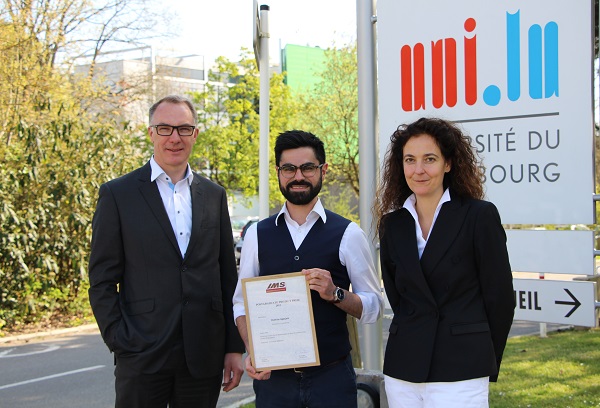
Scientists at the University of Luxembourg have developed new masonry elements for the construction of mortarless walls.
The building elements are simply slotted into one another in an interlocking system, similar to that used with Lego bricks. The researcher Shahriar Agaajani has studied the characteristics of walls built in this way. For his findings, he has now received an international award from the London-based International Masonry Society for the best doctoral thesis of 2015.
The concept of producing masonry elements that can be laid without using mortar in the horizontal joints has enormous benefits. "Using conventional methods you first have to build the wall up to half its full height, and then let it dry before you can continue. With the interlock system, you can build a whole storey in one day and the load of the superstructure can be applied immediately," confirmed Mr Agaajani, who is managing director of the company Asars Constructions and worked half-time at the university conducting research for his thesis. Further advantages of the mortarless wall are the simplicity of handling and laying, and, as a result, faster construction. "Furthermore, it's so much easier to dismantle the building after it has served its purpose. The demolition of dry-stacked walls can be conducted just by unplugging the masonry units allowing the reuse of the elements," explained Professor Danièle Waldmann-Diederich, head of the Solid Structures research group at the University of Luxembourg.
The main scientific output of Shahriar Agaajani’s research was the development of a new numerical technique to determine the extent to which the bearing capacity and weight distribution change in mortarless walls. With walls erected in the conventional way, the mortar between each layer of blocks evenly distributes the load in through the structure. The lack of a load-distributing layer in mortarless walls poses some serious challenges. Even minor relative height differences between neighbouring blocks and geometrical imperfections imply localized and almost unique internal stress distributions induced by external loads within the dry-stacked masonry walls. "No matter how precisely the blocks are manufactured, in practice neighbouring elements will never have exactly the same height," stated Mr Agaajani.
In cooperation with the building materials manufacturer Chaux de Contern, the researchers had prototypes of their blocks manufactured industrially. They used these blocks in their laboratory to build up to 2.5-meter-high walls which were tested experimentally under shear, centric and eccentric loads of up to 180 tons. The overall structural behaviour was compared to conventional masonry systems such as hollow and shuttering blocks. The investigations showed overall relative high structural performances for the developed dry-stacked elements. In addition, Shahriar Agaajani developed an algorithm in order to simulate the load distribution and intensity in the wall in various height-to-length ratios. Using these "virtual walls", the researchers were able to identify potential weak points and then further optimise the construction parts. Worldwide, this is the first time that this simulation technique is used.
In a follow-up project at the University of Luxembourg involving Chaux de Contern and ASARS Constructions, the building blocks will be further developed until they are ready to be brought to market. From 2017, the blocks should be available for use on building sites. "Mr Agaajani and the Solid Structures research group have explored a completely new avenue. Based on theoretical knowledge and the results of the relevant experiments, they have developed a new product which challenges long-established traditions. We hope that customers will follow us along this path," said Eric Klückers, managing director of Chaux de Contern.
Photo © University of Luxembourg (L-R): Eric Klückers, Shahriar Agaajani, Danièle Waldmann-Diederich; Award from the London-based International Masonry Society for the best doctoral thesis of 2015








